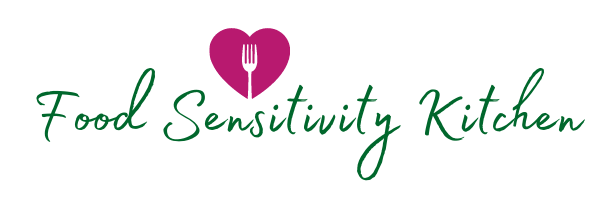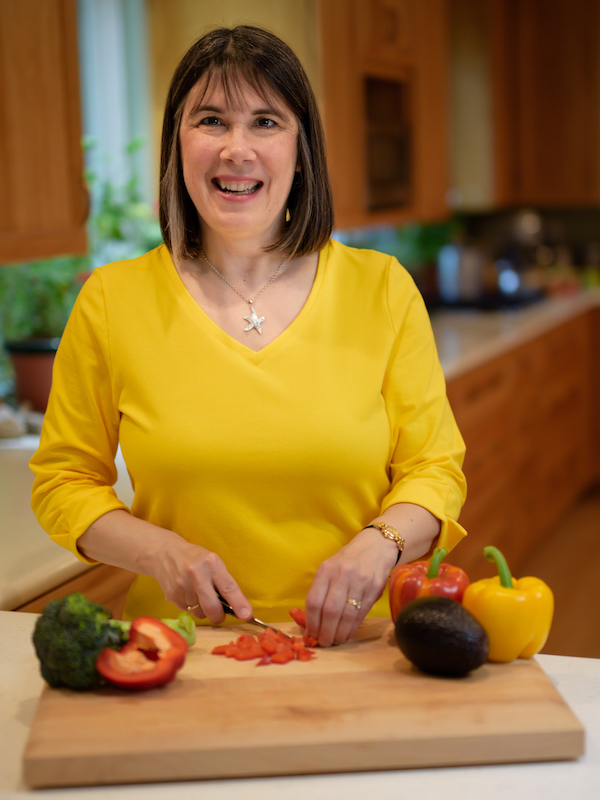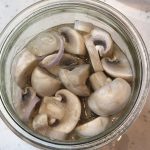
The Cooking Framework Quiz is available by clicking the button below.
Don’t miss an episode!
The button below will take you to Apple Podcasts to subscribe.
Or visit your favorite podcast provider to subscribe.
Thank you!
Transcript
Welcome to The Sensitive Kitchen. Where home cooks are inspired to Cook to Enable Those You Love to Flourish.
I’m Cindy Sullivan, registered dietitian, passionate nutrition educator, and accomplished home cook. Whether you’re changing how you cook for food sensitivities, allergies, intolerances, or just trying to eat healthier on a budget, you’re in the right place. Most episodes, I will share favorite recipes as well as modification tips, and nutrition benefits. Occasionally I’ll have a guest or special episode like modifying holiday favorites.
My favorite foods? They’re raspberries and homemade chocolate chip cookies. My latest cooking project was long fermented sourdough bread.
Welcome to episode 33, What To Do With Too Many Tomatoes. I hope you have this problem this summer.
I hope your summer has been filled with luscious produce, warm summer days and lots of laughter and smiles.
When you do have plenty of ripe tomatoes, it’s a good problem to have, but when they take over your counter, it can be a little daunting. Maybe you grew them yourselves (and the squirrel in your neighborhood did not eat them) or you’re fortunate enough to live near a farmer’s market with the opportunity to purchase a half bushel or even a pack at a reasonable price.
What do you do with your bounty? Besides taking a bite of a raw tomato? We enjoy BLTs for dinner andgazpacho and corn tomato salad. My Mexican squash recipe is coming up next podcast. And what I’m going to talk about today, tomatoes, onions, and peppers.
Today I’m going to share one of my family’s favorite traditional recipes for using lots of tomatoes, but there are so many wonderful things to do with tomatoes. Think about if you want to eat them raw, cooked, or make ahead to freeze. You can also can them, but canning isn’t something that happens in my kitchen. But before we can talk about all the ways you can enjoy them, let’s talk about why you want to – besides great taste and amazing versatility.
What are some of the health benefits of tomatoes?
Tomatoes are the fourth most popular fresh market vegetable in the United States behind potatoes, lettuce and onions.
Tomatoes, along with cucumbers and zucchini are categorized as vegetables, even though they’re botanically fruits. It’s partly due to their lower carbohydrate and sugar content. A medium tomato has just 22 calories, about five grams of total carbohydrate, three is sugar and about one and a half is fiber. But this low calorie, low carb package is bursting with nutrients. And it’s been linked to a variety of health benefits. Let’s talk about some of these.
First of all, let’s talk about heart health. Now we talked about lycopene in episode 006, where I discussed fermented ketchup and an episode 028 where I gave you the recipe for homemade sun dried tomatoes and two recipes for sun dried tomato salad dressing.
But in addition to those, I want to talk a little bit more about lycopene and some of the health benefits. Studies have shown that higher blood levels of lycopene, which is a carotinoid, like beta carotene are tied to lower death rates for people with metabolic syndrome. Now metabolic syndrome is a cluster of risk factors that raises your chance of developing heart disease, diabetes, and stroke.
In terms of heart health tomatoes may be protective for people with type two diabetes. In one study, people with diabetes who supplemented with cooked tomatoes for 30 days experienced a decrease in lipid peroxidation. Lipid peroxidation is a chain reaction in which substances called free radicals attack fat. That leads to damage that increases your risk of heart disease. This is particularly important because diabetes itself doubles your risk of heart disease.
Let’s talk about vision. Tomatoes contain lutein. Remember we talked about lutein last podcast. We talked about fresh corn, tomato salad. Lutein is good for preventing cataracts and macular degeneration.
In terms of cancer, a diet rich in tomato products may help reduce the risk of pancreatic cancer. A study at the University of Montreal found that lycopene provided mainly by tomatoes was linked to a 31% reduction in pancreatic cancer between men with the highest intake and men with the lowest intake you want to be in the highest intake. 33% is a huge reduction in pancreatic cancer.
Tomatoes contain all three high powered antioxidants in terms of vitamins – beta carotene, vitamin E and vitamin C. A U S Department of Agriculture report called “What We Eat in America” noted that a third of us get too little vitamin C and almost half of us get too little vitamin A . Eat a tomato!
These antioxidants and others contained in tomatoes help protect against a variety of cancers, as well as keeping your skin healthy. Interestingly, the tomato skin holds more of these carotinoids and flavonols, which is another family of beneficial phytochemicals. So eat the skin also, at least part of the time!
What you eat with tomatoes remember helps enhance the absorption of carotinoids. Carotinoids are fat soluble compounds. So eat a little fat in the same meal as your tomatoes, whether it’s olive or avocado oil or other fat that you have in your meal.
Let’s look at strong bones. Lycopene may promote bone health and may help prevent the development of osteoporosis. A study published in the Journal of Bone Mineral Research found that participants with higher levels of lycopene in their blood were less likely to experience hip or non-vertebral fractures.
Furthermore, a study published in Osteoporosis International found that post-menopausal women who added lycopene to their diets for four months saw decreased bone breakdown.
We already talked about heart disease, but I didn’t specifically mention stroke. Lycopene may decrease stroke risk. At least in men, there was a 12 year study published in Neurology that middle-aged men with the highest levels of lycopene in their blood had a 55% reduced rate of any kind of stroke and a 59% reduced rate specifically of the most common kind of stroke. The strokes from blood clots.
There is also some research regarding asthma. Some small individuals, excuse me. Some small scale studies suggest that lycopene content in tomatoes may help asthma sufferers. One study was published in free radical research found that taking tomato extract reduced lung inflammation and another study published in allergy found that a daily dose of lycopene for a week reduced exercised induced asthma in 55% of the participants. Researchers suspect that this was because of an antioxidant effect in the lungs. Now these studies – just these last two – were done with supplements, however, lycopene abundant in fresh and especially concentrated in cooked tomato products.
So are you convinced tomatoes are good for you as well as delicious? So how can you use this plethora of tomatoes that lives on your counter, or will soon?
Let’s look at three ways to eat tomatoes: raw cooked for tonight, and cooked for the future.
Let’s start with raw. First of all, the most obvious is rinse, take a bite and enjoy.
We also like BLTs – homemade oatmeal, bread, mayonnaise, fresh lettuce, crisp bacon, and in-season tomatoes. There’s not a better sandwich for summer!
Stuffed tomatoes with salmon or tuna salad, a deceptively quick, but elegant lunch.
Gazpacho. My favorite recipe relies on finely chopped vegetables for uniform flavor and texture it’s worth the work in our opinion, but it doesn’t get made as often as I wish because it is time consuming, but you can find a quicker blender recipe online.
Let’s go to salads. Here’s just a few of our favorites.
Fresh corn tomato salad, listened to last podcast, 032, and go to foodsensitivitykitchen.com/episode032 for the recipe.
Chopped tomatoes with feta and a flavorful, perhaps balsamic vinegar like Trader Joe’s balsamic vinegar of Moderna or Fustini’s 18 Year Balsamic. Yum!
Another salad is raw with cucumbers. So chop cucumbers, chopped tomatoes, chopped feta and your favorite vinegar like Fustini’s grapefruit or pomegranate or Pompian and red wine vinegar, Add a few olives if you like.
The last salad is one of my favorite tomato recipes – Tomato Peach Salad. I only make it one month out of the year because it’s best with in-season peaches and in-season tomatoes, but oh, it is a match made in heaven! Email me if you want the recipe.
Let’s go from raw tomato recipes to cooked. Now I’m going to divide these into two categories. One is large batch for your freezer and the other is for dinner tonight, or maybe tomorrow with leftovesr for lunch.
So large batch for your freezer – tomatoes, onions, and peppers, which I’m going to talk about in just a moment. Eggplant, caper sauce is another favorite in my family and it’s loaded with tomatoes. And so is Ratatouille.
For dinner tonight.
maybe you want to make our family’s favorite tomato cream sauce,
or you want to take those tomatoes (and Roma’s work especially well here) hallow them stuffed them with goat cheese, olives, pine nuts, and a few spices.
Or if you have cherry tomatoes, maybe you want to cut them in half, roast them with garlic and balsamic vinegar and serve with fresh baisil either over fish and over pasta.
Mexican squash is a great way to use them. And that’s coming up in the next episode in two weeks.
Maybe you just want to cut your tomatoes in half, put them under the broiler after you sprinkle them with Parmesan or coat them with olive, avocado oil and herbs.
Let’s talk about this recipe that uses lots of tomatoes.because I still haven’t forgotten that they’re covering your counter, right?
Three ingredient wonders. Do you have any of these simple family recipes in your recipe repertoire?
When my grandma and her sister visited our house soon after Tim and I were married, my great aunt said to me, you make that too? Tomatoes, onions, and peppers. Her mother made it. My grandmother made it. My mother made it and I make it.
Tomatoes, onions, and peppers is comfort food in my house. The tomatoes cooked down into a thick, luscious condiment. I freeze it and ration it in my house so we have the taste of summer all year long.
This simple three ingredient recipe uses LOTS of tomatoes. You are really only limited by the size of your pan. Use a wide pan so the liquid can evaporate more quickly. I can put almost six quarts of tomatoes in my six quart saute pan. The peppers and onions (or shallots) are really more of just a flavoring in this dish.
This is going to cook for about an hour, maybe more. So do this while you plan to be at home, you only need to stir it occasionally after it comes to a boil.
How do you eat tomatoes, onions, and peppers? We eat it with chicken or turkey sausage, fish chicken that’s either been grilled or baked or poached. We freeze it and use it all year long. Tonight we had it with zucchini pancakes, Yum!
There are only three ingredients, but it’s important that you only want to make this when you have in-season ripe tomatoes.
If some of your ripe tomatoes have sat on the counter a day or two long and have a couple spots it’s okay. Just cut out the spots and use the rest in this recipe. No one will ever know. You can also sneak a few less ripe tomatoes in here. As long as the vast majority are completely ripe, you’ll be okay. So in season tomatoes is your first ingredient.
The second is green bell pepper, and the third is a small onion or shallot preparation.
The most time consuming part is chopping the tomatoes. So my tips are after you rinse your tomatoes, core them, slice them in half inch slices, stack two slices together and slice them in half inch strips, turn them 90 degrees cut each half into half-inch cubes. Put the tomatoes in a bowl or right into the pan. You’ll get faster after you chop a few pans!
For your sweet green pepper. You want to core it and cut it in half. Slice each half into two or three sections depending how big your pepper is. And if your pepper’s very big, you might want to cut each half into three or four pieces,
Slice the short way into strips. But you’re probably only going to use about half of a large pepper for about six quarts of tomatoes. So you don’t need a lot of peppers, shallots or onions.
You’ll need a large shallot or two really small ones or about half of a smallish onion. So you’re going to cut off the ends. Take off the brown outer layer, Slice the onion or shallot in half lengthwise. Put the cut side down on the cutting board, then slice it in half lengthwise again and slice it into slices.
Put all your ingredients into a pan. And as I mentioned, a large saute pan is best with a big area, cook it over medium heat until the mixture comes to a boil and you’re stirred occasionally and you cook and you cook and you continue to cook when it’s done.
Most of the water will have evaporated from the pan. And then when the mixture is stirred, a trail will be left where the spoon goes as a hint. If you have a screen that covers your pan, use it. It’ll keep your stove cleaner from tomato splatters, Serve It and freeze any leftovers. I freeze it in one, two and three cup containers to enjoy all year.
Thanks so much for listening today. Email me it, Cindy, at food sensitivity, kitchen.com. And tell me, how do you enjoy tomato season? I would love to know what your family does with extra tomatoes. What are your favorite recipes? How do you eat them? Remember the recipe as well as lots of pictures and instructions as well as this transcript can be found at food sensitivity,
kitchen.com/episode 0 3, 3. I hope you enjoy these last months of summer and as a months plural. Cause I kind of count September as being a little bit of summer. So I hope you’re enjoying these days that they are wonderful for you and your family and that you’re still able to get out and enjoy the glorious days that we’re having. Have a great week. I look forward to hearing from you soon.
Take care. Bye bye.
References
Cancer-Fighting Tomatoes
webMD Cancer Center
https://www.webmd.com/cancer/ss/slideshow-cancer-fighting-foods?ecd=wnl_faf_080421&ctr=wnl-faf-080421_lead_cta&mb=JqRwSuhWRse5oukQ6d83n3g0WleHxvIqdStq10IV7Jw%3D
Everything you need to know about tomatoes by Megan Ware, RDN, LD 9/25/2017
Medical News Today
https://www.medicalnewstoday.com/articles/273031
Health Properties of Tomatoes By Elaine Magee, MPH, RD
https://www.webmd.com/food-recipes/features/health-properties-tomatoes
Tomatoes Health Benefits
https://www.health.com/nutrition/health-benefits-tomatoes
7 Health Benefits of Tomatoes By Cynthia Sass, MPH, RD Updated August 02, 2018
Tomatoes: Health Benefits & Nutrition Facts By Jessie Szalay April 30, 2016
https://www.livescience.com/54615-tomato-nutrition.html
LiveScience




